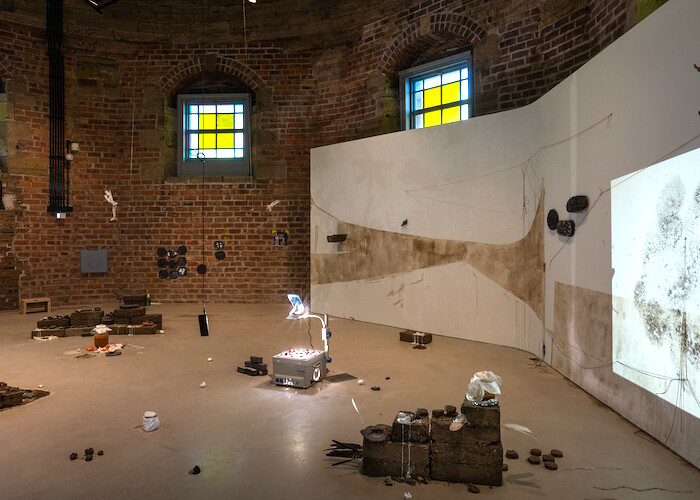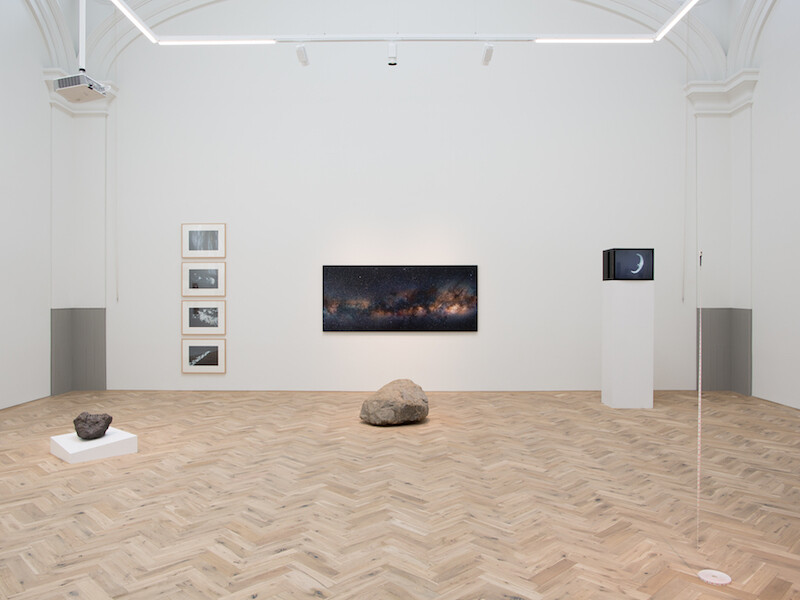Categories
Subjects
Authors
Artists
Venues
Locations
Calendar
Filter
Done
January 16, 2019 – Review
Dineo Seshee Bopape’s "〰️ [when spirituality was a baby]”
Tom Jeffreys

At once named and unnamable, Dineo Seshee Bopape’s installation 〰️ gathers myriad references (astrology, classical sculpture, Afrodiasporic spiritual practices, the Anthropocene) and materials (soil and rocks, satin and spices, glass and plastic, charcoal, jute, feathers, clay). It weaves them together thrillingly, with gold wire, cotton thread, and lines scraped into the concrete floor. In scale, the installation oscillates from tiny holes made by drawing pins to the vastness of a universe. Seen as a single entity, this is a work that marks itself, maps itself, archives its own making and its own meanings. It is a work that prompts a pile-up of words and renders them all inadequate. All my notes are lists.
The first mystery of the exhibition is its title: a glyph designed by the artist consisting of six wavy vertical marks, represented here by the “〰️” symbol. In print it is like rising steam (or is it falling rain?). Scratched into the gallery floor, or marked in tiny biro lines on the wall, these wobbly lines read more like the Egyptian hieroglyph for water: a linguistic echo of tidal marks in sand or the flowing of a river. It does not translate into letters or sound or language; …
September 11, 2018 – Review
“Jacob’s Ladder” and “Astronomy Victorious”
Crystal Bennes

In an episode of the experimental storytelling podcast Imaginary Advice, host Ross Sutherland reflects on the way cultures over the centuries have exaggerated the meaning of the moon, distorting it from astronomical body into an open, figurative channel. “The moon has a powerful gravitational field,” Sutherland says. “In poetry, the moon draws in concepts, it draws in language. Words just seem to stick to the moon. I maintain that a poet can pretty much compare the moon to anything.”
Two recent exhibitions exploring the moon’s magnetic allure are “Jacob’s Ladder” and “Astronomy Victorious,” a two-part display across Ingleby and the University of Edinburgh Main Library. Although the two shows ostensibly survey humanity’s broader relationship with the universe through a combination of contemporary artworks and rare books, the most compelling works share a lunar focus. The unofficial figurehead of both exhibitions is the nineteenth-century Scottish engineer and artist James Nasmyth. Both galleries display plates from Nasmyth’s 1874 book The Moon Considered as a Planet, a World, and a Satellite, which reveal the author’s deep curiosity and ingenuity in pursuit of the moon’s mysteries. Hindered by early photography’s technical limitations, Nasmyth was unable to take close-up photographs of the moon. Instead, he collaborated …
